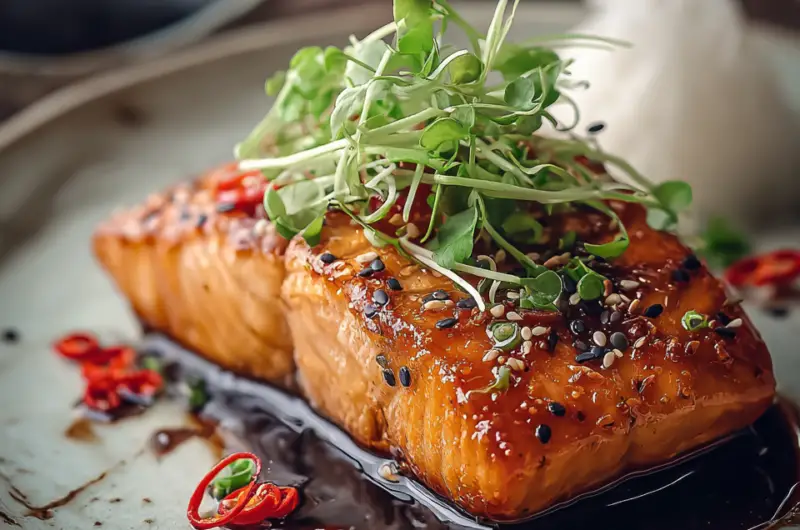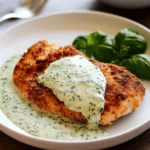The elegance of this dish lies in its simplicity. Inspired by the iconic Nobu miso black cod, this miso salmon takes the same concept and adapts it to a more accessible, equally luxurious format. The combination of sweet mirin, fragrant sake, and deep umami from the miso paste forms a glaze that caramelizes beautifully under the broiler. What makes this dish a true favorite is how it balances gourmet flavor with straightforward technique. You’ll be amazed at how a quick marinade and a few minutes under the broiler can deliver restaurant-level results. It’s a perfect option for impressing guests—or simply treating yourself to a bit of weeknight indulgence.
Full recipe:
Ingredients:
-
¼ cup mirin
-
¼ cup sake
-
⅓ cup miso paste
-
⅓ cup cane sugar
-
2 lb salmon, deboned and cut into filets (about 4 fillets)
Directions:
-
In a small saucepan over medium heat, combine mirin and sake. Bring to a gentle boil and let simmer for 3 minutes.
-
Reduce heat to low, add sugar and miso paste, and stir until fully dissolved and smooth (do not let boil). Let the mixture cool.
-
Place the salmon fillets in a resealable plastic bag or airtight container. Pour half (or all) of the cooled miso glaze over the fish, ensuring each fillet is well coated.
-
Marinate in the refrigerator for at least 24 hours (up to 60 hours for deeper flavor), turning occasionally.
-
Preheat the oven broiler on high. Line a baking sheet with foil and place the salmon skin-side down.
-
Broil the salmon for 5–10 minutes, keeping a close eye to prevent burning. The glaze should caramelize, and the salmon should reach an internal temperature of 145°F (63°C).
-
Remove from the oven and serve immediately, ideally with steamed rice and vegetables.
Prep Time: 10 minutes | Marinating Time: 24–60 hours | Cooking Time: 10 minutes | Total Time: 24 hours 20 minutes
Kcal: 473 kcal | Servings: 4 servings
A Gourmet Classic Made Simple: The Story Behind Nobu Miso Salmon
The Nobu Miso Salmon is inspired by one of the most iconic dishes served at Nobu Matsuhisa’s legendary restaurants—the miso black cod. Famed for blending Japanese culinary traditions with Peruvian influences, Chef Nobu brought miso-marinated fish into global culinary limelight. While the original dish features black cod, our adapted version uses salmon—more accessible and just as rich in flavor and texture.
The beauty of this recipe lies in its balance: the miso provides deep umami, the sugar adds a gentle sweetness that caramelizes during broiling, and the sake and mirin give the glaze its aromatic complexity. With just a handful of ingredients and minimal effort, this recipe delivers a luxurious experience that echoes high-end dining—without the need for a reservation.
Why Salmon Works So Well With Miso
Salmon, with its rich, buttery flesh and naturally oily texture, is the perfect canvas for a miso glaze. It holds up beautifully to high-heat cooking like broiling, allowing the surface to caramelize while the inside remains moist and flaky.
The natural fats in salmon enhance the umami of the miso and help carry the subtle sweetness of the sugar and mirin throughout the dish. This marriage of fat and umami is what makes this version so irresistible—and arguably more decadent than the traditional black cod counterpart.
Health Benefits That Make This Dish Even Better
Nobu Miso Salmon is not only delicious but also nutritionally balanced. Each serving packs in approximately 48 grams of protein with just 473 kcal, making it an ideal option for those following a high-protein diet. Let’s break down a few specific benefits:
- Rich in Omega-3 Fatty Acids: Salmon is well-known for its high levels of omega-3s, which support heart health, reduce inflammation, and improve cognitive function.
- Low Sugar Load: Although the glaze contains sugar, the amount per serving is modest, and the protein and healthy fats help balance blood sugar spikes.
- Miso’s Gut Health Benefits: Miso is a fermented product, and while some probiotic benefits are diminished during cooking, it still contributes to digestive health when used regularly.
- Low-Carb Friendly: With only 29g of carbohydrates and 1g of dietary fiber per serving, it suits many low-carb and moderate-carb dietary preferences.
It’s a meal that feeds the body as well as the soul.
The Magic of Marination: Why Time Matters
One of the key elements in this recipe is the marination time. While 24 hours is the minimum, marinating for up to 60 hours allows the flavors to fully penetrate the salmon. This slow marination infuses the fish with depth and complexity that quick glazes simply can’t replicate.
The combination of miso’s saltiness, sake’s fermentation, and sugar’s sweetness creates a chemical reaction during the broiling process that results in that famous golden-brown crust. It’s a technique that honors traditional Japanese preservation methods while producing gourmet results.
Perfect Pairings: What to Serve with Nobu Miso Salmon
To make a well-rounded and restaurant-quality meal, consider pairing Nobu Miso Salmon with:
- Steamed Jasmine or Sushi Rice: Its neutral base complements the sweet-salty glaze.
- Garlic Sautéed Bok Choy or Broccolini: Adds freshness and texture.
- Pickled Cucumber Salad or Seaweed Salad: For acidity and crunch to balance the richness.
- Miso Soup or Edamame: Classic Japanese sides to complete the experience.
Drizzle a few drops of ponzu sauce or serve with a wedge of lemon to enhance brightness if desired.
Kitchen Tips and Tricks for Success
Here are a few expert tips to ensure your Nobu Miso Salmon turns out perfectly every time:
- Avoid Boiling the Glaze: Overheating the miso can cause it to separate or become bitter. Let the glaze cook gently and cool completely before marinating the salmon.
- Use Skin-On Fillets: The skin helps keep the fillet intact during broiling and adds a layer of crispness if properly cooked.
- Foil is Your Friend: Always line your baking sheet with foil. The glaze will caramelize and stick to the pan otherwise, making cleanup a nightmare.
- Watch Closely While Broiling: Because of the sugar content, the glaze can burn quickly. Keep a close eye and pull it out once you see bubbling and golden-brown patches.
- Use Fresh Salmon When Possible: Fresh, high-quality salmon elevates this dish to the next level. However, thawed frozen salmon can work beautifully as well—just pat it dry thoroughly before marinating.
A Make-Ahead Entertaining Secret
This dish is the ultimate make-ahead recipe for entertaining. Since the marination takes place the day before, all you have to do is broil the salmon just before serving. This allows you to enjoy your time with guests rather than spend hours in the kitchen.
It’s an ideal main course for a dinner party, anniversary, or date night at home. The glaze gives it a glossy, restaurant-worthy appearance, and the first bite never fails to impress.
You can also prep the glaze in bulk and freeze it in portions for future use. It works beautifully with other proteins like chicken thighs or tofu, making it a versatile base for weeknight meals.
Sake and Mirin: A Lesson in Japanese Pantry Staples
Two essential ingredients in this recipe—sake and mirin—may not be everyday staples in every kitchen, but they’re worth the purchase. Here’s why:
- Sake is a rice wine that enhances the umami in savory dishes. It also helps tenderize the protein during marination.
- Mirin is a sweet rice wine with a syrupy consistency that adds subtle sweetness and depth to glazes and sauces.
Together, they create a distinct flavor profile that can’t be replicated with simple sugar and vinegar substitutes. Look for them in the international aisle of most grocery stores, or at Asian specialty markets.
How This Dish Aligns with Modern Food Trends
Nobu Miso Salmon aligns perfectly with several current food trends:
- Fusion Cuisine: A mix of Japanese and Western techniques and ingredients.
- Minimalist Recipes: Just a few ingredients, but maximum flavor.
- Elevated Home Cooking: Restaurant-level meals prepared in your own kitchen.
- Mindful Eating: A focus on quality ingredients, balanced nutrition, and intentional preparation.
Whether you’re a seasoned cook or just getting comfortable in the kitchen, this dish gives you the confidence to serve something extraordinary with minimal effort.
Is Miso Salmon the Same as Teriyaki Salmon?
While they may seem similar at first glance, miso-glazed salmon is distinctly different from teriyaki salmon. Teriyaki sauce is typically made with soy sauce, sugar, and mirin, while miso glaze is thicker and has a more intense umami depth due to the fermented miso paste.
The caramelization you get from miso is richer and more complex, offering a nutty, almost cheesy undertone that teriyaki lacks. It’s less salty, slightly funkier, and overall more nuanced—ideal for the sophisticated palate.
Conclusion
Nobu Miso Salmon is a stunning example of how traditional Japanese techniques can be adapted for everyday cooking while still delivering luxury-level flavor. With a rich miso marinade, a simple broiling method, and a short list of ingredients, this dish combines elegance, ease, and nourishment in one unforgettable meal.
Whether you’re cooking to impress or simply craving something special, this recipe delivers every time. It proves that you don’t need a Michelin-starred kitchen to eat like royalty—just a little patience, the right ingredients, and a love for flavor.








